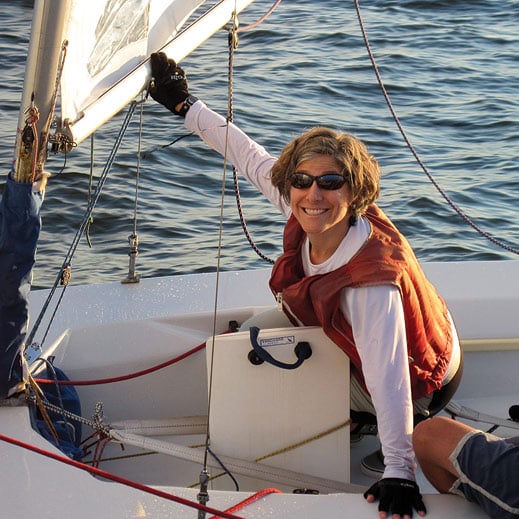Elizabeth Lurie, SM ’93, ScD ’96
Beth Lurie went sailing at every opportunity while she was growing up on Long Island Sound. Her 10-year career in yacht racing and design has nicely integrated her academic and personal passions.

After graduating from MIT with degrees in ocean engineering and aeronautics and astronautics—she raced occasionally in the Institute’s evening racing series—Lurie joined United Technologies Research Center (UTRC), where she developed fans for Carrier, the company’s air-conditioning and commercial refrigeration division. Shortly after her arrival, UTRC’s parent company, United Technologies Corporation (UTC), became a corporate sponsor for AmericaOne, a U.S. yacht-racing syndicate seeking entry in the America’s Cup.
Through UTRC, Lurie joined the AmericaOne team as a performance analyst, developing underwater instrumentation to improve the performance of the boat’s rudder and keels for the 2000 Louis Vuitton Cup, where a first-place finish qualified for the America’s Cup. AmericaOne finished second in the Vuitton Cup and UTC left the syndicate, but Lurie was hooked on America’s Cup racing.
“For each America’s Cup cycle, we had three sailing seasons—three chances—to have the fastest boat possible,” she says. “Yacht design changes so fast—so many aspects of a previous race boat are obsolete in the next event.”
In 2001, Lurie left UTRC and joined OneWorld Challenge, another U.S. syndicate, in preparation for the 2003 America’s Cup. Her responsibilities included overseeing both wind tunnel testing and on-the-water testing. After OneWorld did not qualify for the America’s Cup, she joined the Luna Rossa Challenge for the 2007 Vuitton Cup. In that event, Luna Rossa’s boat finished second, one spot short.
Despite never qualifying for the America’s Cup, Lurie has fond memories of the yacht-racing competitions.
“Each sailing season was more fun than the last,” she says. “The tools and systems are better than the previous generation, and the pace of technology growth was breathtaking.”
After the 2007 race Lurie rejoined UTRC as a research engineer, helping develop high-compression units for aerospace and HVAC applications. In 2011, she moved to Pratt & Whitney as manager of the aerothermal methods group, where she oversees development of computational fluid dynamics software used to design jet engines.
“Pratt & Whitney has so much technical talent and knowledge, but unlike sailboat racing, the engine development and FAA certification process is much more deliberate and lengthy,” she says. “The similarity between the two products is that it takes a technological advantage to win, and strong teamwork to achieve success.”
For Lurie, who has a bachelor’s degree from Dartmouth College, sailing still remains a passion. Living near the Connecticut shoreline, she and her husband have a date night on the sea every summer Thursday, and their three children are all avid sailors.
“Sailing is our primary family activity,” she says. “We all enjoy being out on the water together—it will always be an important part of our lives.”
Keep Reading
Most Popular
Large language models can do jaw-dropping things. But nobody knows exactly why.
And that's a problem. Figuring it out is one of the biggest scientific puzzles of our time and a crucial step towards controlling more powerful future models.
How scientists traced a mysterious covid case back to six toilets
When wastewater surveillance turns into a hunt for a single infected individual, the ethics get tricky.
The problem with plug-in hybrids? Their drivers.
Plug-in hybrids are often sold as a transition to EVs, but new data from Europe shows we’re still underestimating the emissions they produce.
Stay connected
Get the latest updates from
MIT Technology Review
Discover special offers, top stories, upcoming events, and more.